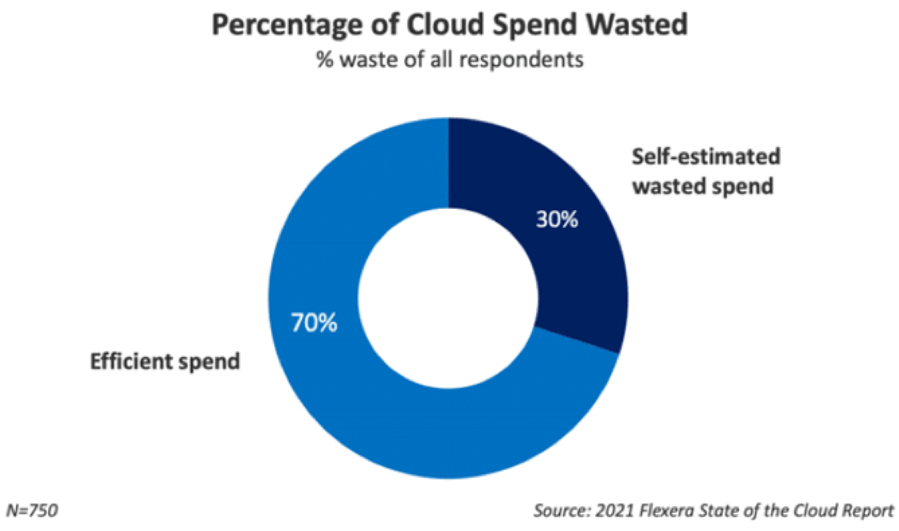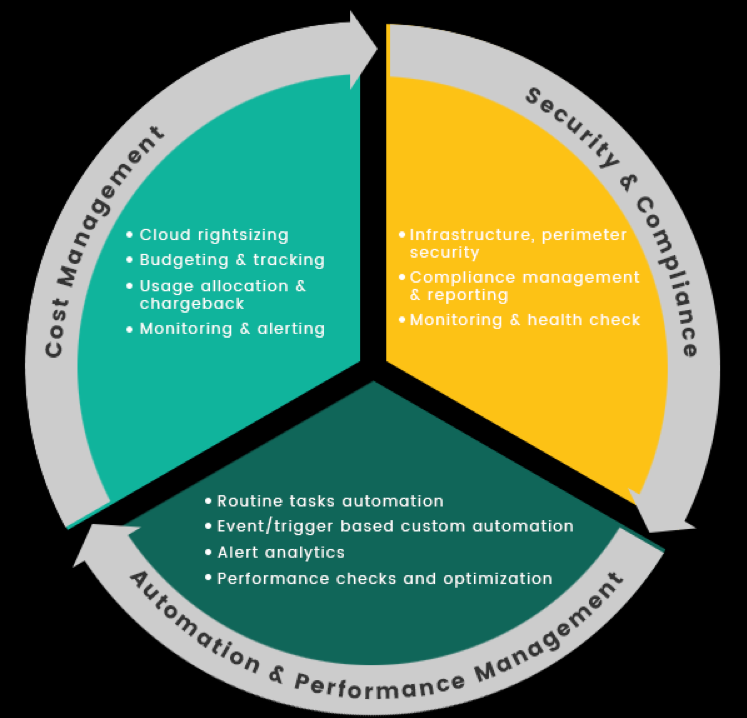Hello!
 Gartner predicts that public cloud consumption is expected to grow by 23.1% in 2022 and reach $332 million, a significant upward trend from $270 million in 2021.
Gartner predicts that public cloud consumption is expected to grow by 23.1% in 2022 and reach $332 million, a significant upward trend from $270 million in 2021.
Amazon, Microsoft, and Google have made the public cloud more accessible than ever for small to medium businesses (SMBs) and startups.
Having said that, one of the mistakes that many IT organizations make is treating the shift to the public, private or hybrid cloud just as a shift to another data center. This mistake often adds thousands of dollars in unnecessary overhead after the migration.
You cannot just implement the cloud and cross your fingers hoping for the best outcome. You need a well-thought-out IT infrastructure management plan that ensures your business makes the most of the cloud model in the long run.
In this article, we are going to look at 4 keys to establish an effective and efficient cloud management system in your organization.
Start with Resource Planning
 The “type” of cloud deployment (private, public, or hybrid) you choose for your organization doesn’t matter unless you go in with a plan. The Flexera 2021 State of the Cloud Report found that most organizations waste 35% of their cloud spend. This can be drastically reduced by adequate resource planning.
The “type” of cloud deployment (private, public, or hybrid) you choose for your organization doesn’t matter unless you go in with a plan. The Flexera 2021 State of the Cloud Report found that most organizations waste 35% of their cloud spend. This can be drastically reduced by adequate resource planning.
Resources in SMBs are not always abundantly available and this makes having an effective cloud management strategy all the more important.
 In a nutshell, here are a few areas that take up the majority of unexpected costs:
In a nutshell, here are a few areas that take up the majority of unexpected costs:
- Unscheduled maintenance and upgrades
- Customizations
- Disaster recovery
- Security incidents
- Business growth that requires additional compute capacity
 To formulate an effective cloud management strategy, consider the following resource-related factors very carefully:
To formulate an effective cloud management strategy, consider the following resource-related factors very carefully:
- When it comes to cloud deployment, don’t just follow the herd or adopt technology that is “in” at the moment. Analyze the scale and nature of your operations, your customers, the kind of products/services you offer, and your existing IT infrastructure. Then decide on the workloads you will move to the cloud.
- When migrating to the cloud, don’t go all-in at once. Start with services that you can move to the cloud with minimum associated risk or minimum disruption to everyday operations. This will get your proof of concept and help you tweak the deployment for maximum efficiency as and when it is happening.
- As mentioned earlier, it is very easy to miscalculate the true cloud environment costs. For instance, you might over-provision for resources when buying off packages from a public cloud provider. Additional features according to your specific compliance or integration requirements might cost more. Further, a lack of standardization or vendor lock-in might prevent you from getting the best deals that are available in the market.
Prioritize Performance
 Agility and performance benefits are major motivators behind any organization’s decision to make the shift to the cloud. Business needs are becoming more complex by the day as big data processing demands the need for more application flexibility and more compute resources.
Agility and performance benefits are major motivators behind any organization’s decision to make the shift to the cloud. Business needs are becoming more complex by the day as big data processing demands the need for more application flexibility and more compute resources.
In the tech-savvy enterprise, this is made possible by a combination of virtualization and cloud-native app development. Even if you don’t have deep pockets, a unified hybrid and multi-cloud environment serve you best.
Always consider factors that can remotely hinder the overall performance or delivery of your services. For instance, defining clauses in your SLA (service level agreement) for redundancy, load balancing, regular backups, and scheduled maintenance are must-haves for ensuring uninterrupted operations and transactions in the cloud.
1. Sudden usage spikes:
You must plan for predictable and unpredictable usage spikes. Many organizations use a combination of private cloud and public cloud to take care of this.
Such situations are handled by a hybrid cloud using a technique called “cloud burst” by which the regular computational load is handled by the private cloud but the additional resource demands are “burst” to the public cloud when the private cloud reaches its 100% capacity.
2. Data backup & disaster recovery:
 Just like any data center or on-premises environment, backup and recovery should be an integral part of every cloud architecture, especially for business-critical applications.
Just like any data center or on-premises environment, backup and recovery should be an integral part of every cloud architecture, especially for business-critical applications.
Disaster Recovery works by creating redundant copies of business-critical applications (often, in a multi-cloud or hybrid environment) to ensure business continuity in the event of an unforeseen disaster.
3. Development & testing
In many organizations, development is carried out and supported on a full-fledged cloud whereas legacy systems are used for testing. This strategy is not always ideal.
An effective cloud management strategy should help an enterprise choose the perfect multi-cloud or hybrid environment, based on the real-time computational requirements for development, testing, or regular workload processing.
Automate Wherever Possible
Cloud automation helps you make the most of the compute capacity you have available in terms of both technology resource management and operational productivity. Automation helps developers, admins, and cloud architects create and destroy cloud environments on-demand. This enables quick testing or execution of time-limited projects.
 However, cloud automation requires the use of specialized tools which could be specific to your cloud vendors such as AWS or Google Cloud Platform.
However, cloud automation requires the use of specialized tools which could be specific to your cloud vendors such as AWS or Google Cloud Platform.
Bear in mind that while automation lets you carry out transactional tasks, it can’t “manage” the cloud or take strategic decisions for you. This can be done by the right cloud management platform that puts in place a process that keeps your cloud workflow going smoothly and quickly.
That said, “cloud orchestration” goes one step beyond cloud automation by allowing you to schedule and integrate automated tasks between disparate systems.
Orchestration tools such as Kubernetes and Cloudify enable you to perform automated tasks in a sequence or at certain times. They can also monitor the health of the system using a methodology called “observability.”
Ensure Security & Compliance at All Times
Most organizations that don’t have a well-defined cloud management strategy in place are caught in the chaos of technical complexities sooner or later. While most major cloud providers have assurances in place for the security of your IT infrastructure, it is ultimately a shared responsibility.
Many organizations still use legacy ideas in security systems for cloud operations. But what worked for traditional on-premise applications and data centers will not work in the cloud. Whenever sensitive business data—like healthcare and financial details—is stored in public cloud systems, the providers and their clients become irresistible targets for hackers.
 Unlike an on-premise system, the public cloud limits the extent of control and customization you have over your data because most of the time the underlying applications are built by the vendor. You need to change application architectures to make them more secure in such scenarios. Another approach is to clearly define the perimeters of the network to limit exposure to data and files.
Unlike an on-premise system, the public cloud limits the extent of control and customization you have over your data because most of the time the underlying applications are built by the vendor. You need to change application architectures to make them more secure in such scenarios. Another approach is to clearly define the perimeters of the network to limit exposure to data and files.
Depending on the cloud model that is in use in your organization, your cloud management strategy must define policies for user access, regular penetration testing, and auditing, and dealing with security incidents or breaches.
This will help you constantly monitor your cloud infrastructure to spot and fix any potential security threats as they arise.
Also read:
- Tips for Implementing Sustainable Strategies in Your Business
- Not All Game-Changing Analytics Are Complicated
- This AI Will Show You What Your Future Children Might Look Like—Just Upload Your Photos
Over to You
The benefits of the cloud for your organization are only as good as your technical expertise and operational processes. These pointers will help you create a foolproof cloud management strategy plan to help you reap the benefits of the cloud in the long run.
Having said that, you should stay on top of key performance metrics of your cloud infrastructure performance and upgrade it regularly to keep up with your organization’s growth. Good luck!
Thank you!
Join us on social networks!
See you!






